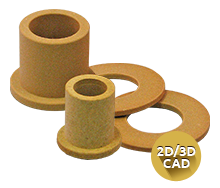Category Archive: Bearings

Self-lubricating bearings are quietly transforming industries worldwide, offering unparalleled benefits such as reduced maintenance, enhanced reliability, and improved sustainability. But how exactly do they work, and why are they increasingly becoming the go-to choice for engineers across various sectors?
In this comprehensive guide, we’ll explore the mechanics of self-lubricating bearings, their cutting-edge materials, diverse applications, and their significant impact on the future of engineering. Whether you’re an industry professional or a curious reader, this deep dive will leave you informed and inspired. Feel free to also explore findings from Nasa’s research center.
1. The Mechanics of Self-Lubricating Bearings
At their core, self-lubricating bearings are engineered to reduce friction and wear without requiring external lubrication. This is achieved through an innovative internal system that ensures consistent performance.
The Science Behind It
- Porous Materials: These bearings are often made from sintered bronze, composites, or advanced polymers, which contain microscopic pores filled with lubricant.
- Heat and Pressure Activation: During operation, friction generates heat, causing the lubricant to seep from the pores, creating a thin film that minimizes wear and reduces friction.
Key Benefits
- Enhanced Performance: Reliable operation even in high-load or high-temperature environments.
- Longer Lifespan: Reduced wear means these bearings often outlast their traditional counterparts.
- Maintenance-Free: No need for routine lubrication, saving time and resources.
2. Advanced Materials and Their Role
The materials used in self-lubricating bearings are pivotal to their performance, dictating their load capacity, temperature tolerance, and suitability for specific applications.
Material Breakdown
- Bronze Bearings: Infused with oil, these are ideal for heavy-duty operations and extreme temperatures.
- Polymer Bearings: Lightweight and corrosion-resistant, perfect for applications in wet or chemically aggressive environments.
- Metal-Polymer Composites: These combine the strength of metals with the low-friction properties of polymers, offering versatile solutions.
Cutting-Edge Innovations
Modern advancements have pushed the boundaries of material science. For instance:
- Bearings capable of withstanding temperatures up to 500°F.
- High-strength composites designed for aerospace and defense, enduring extreme pressures and harsh conditions.
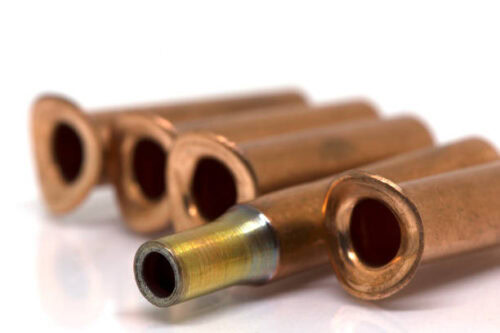
3. Applications That Push the Limits
Self-lubricating bearings thrive in challenging environments where traditional lubrication systems often fail. Let’s explore their applications across various industries.
- Usage: Found in steering systems, suspension, and transmission components.
- Benefits: Maintenance-free operation enhances reliability and reduces overall vehicle weight.
Aerospace
- Usage: Lightweight bearings are used in landing gear and control systems.
- Benefits: Lower fuel consumption and the ability to withstand extreme temperatures and pressures.
Food Processing
- Usage: Employed in conveyors and mixers.
- Benefits: Made from FDA-approved materials, they ensure safety and hygiene.
Medical Devices
- Usage: Found in surgical instruments and diagnostic equipment.
- Benefits: Silent operation and zero maintenance requirements make them indispensable.
Pro Insight:
Industries are continuously discovering new applications, leveraging the adaptability and efficiency of self-lubricating bearings.
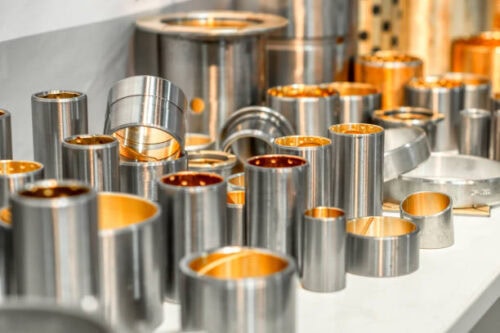
4. The Long-Term Benefits of Self-Lubricating Bearings
Switching to self-lubricating bearings is more than just an operational upgrade; it’s a strategic move with long-term advantages.
Cost Savings
- Eliminate the need for lubrication systems, reducing upfront and ongoing expenses.
- Lower maintenance costs and downtime.
Environmental Impact
- Reduced dependency on oil-based lubricants.
- Less waste and lower carbon footprint contribute to sustainability goals.
Enhanced Reliability
- Consistent performance under varying conditions reduces the risk of equipment failure.
- Increased uptime translates to better productivity and profitability.
Sustainability Spotlight
Industries are leveraging self-lubricating bearings to meet stringent environmental regulations without compromising performance or efficiency.
Conclusion: The Future of Engineering
Self-lubricating bearings represent a technological breakthrough that saves time, money, and resources while delivering unmatched reliability. As industries push the boundaries of innovation, these bearings will continue to play a critical role in achieving efficiency and sustainability.
Discover how Bunting Bearings’ wide range of self-lubricating solutions can enhance your next project. Contact us today for tailored recommendations and industry-leading products.
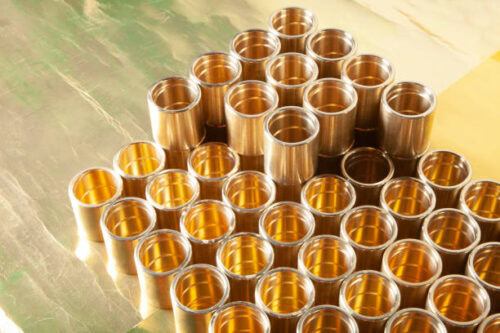
The Past, Present, and Future of Metal Prices: Impact on Bearings and Bushings Industry

Metals like bronze, brass, aluminum, and iron-copper alloys are the foundation of many industrial components, especially bearings and bushings. These materials provide the essential mechanical properties needed for precision components used across industries such as automotive, aerospace, heavy equipment, and energy. Fluctuations in metal prices directly influence the cost, design, and availability of bearings, which impacts companies like Bunting Bearings. This article explores the historical evolution of metal prices, analyzes current market conditions, and forecasts future trends, with a particular focus on metals crucial to the bearing and bushing industries.
A Historical Overview: Metal Prices and Bearings/Bushings
Historically, the prices of metals have experienced substantial fluctuations, largely driven by global economic cycles, industrial revolutions, and technological advancements. For instance:
- Bronze, a key material for bushings and bearings, has been in demand since the Bronze Age due to its anti-corrosive properties and high wear resistance. However, the reliance on copper, a component of bronze, means the price of bronze has mirrored copper price trends.
- The mid-20th century industrial boom saw prices of industrial metals surge due to increased infrastructure projects and manufacturing demands. The rise of the electrical industry created sustained demand for copper, essential for power grids and electrical motors.
- Powdered metals emerged as an innovative manufacturing process during the 20th century, enabling efficient production of self-lubricating bearings. Companies like Bunting Bearings capitalized on this by producing SAE 841 bronze and SAE 863 iron-copper bars, optimized for low-friction, high-durability applications
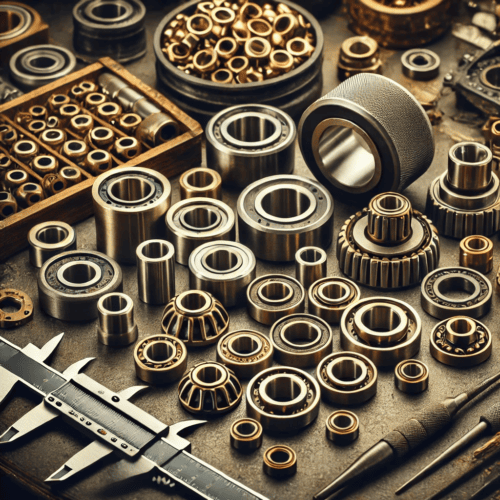
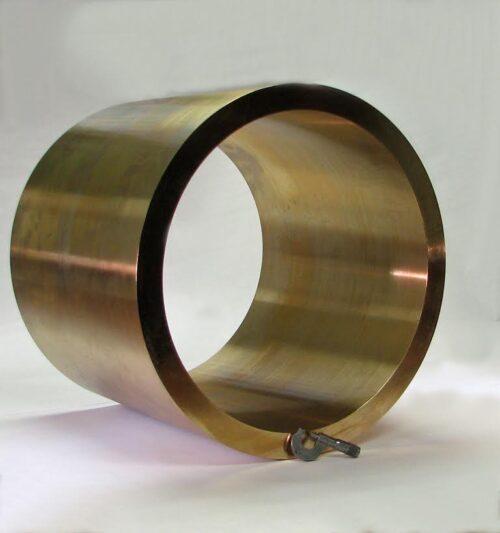
The Current State of Metal Prices: A Market in Flux
The pricing of metals such as bronze, aluminum, and copper remains highly dynamic. Several key factors shape the current metal market:
Global Supply Chain Disruptions and Inflation
- The COVID-19 pandemic caused major disruptions in mining operations and transportation, leading to reduced metal supply.
- Geopolitical conflicts, such as the Russia-Ukraine war, affected the supply of critical industrial metals like aluminum, causing market volatility
Growing Demand from Green Energy Sectors
- Copper and aluminum are in high demand for their use in electric vehicles (EVs) and renewable energy infrastructure. Bearings used in wind turbines and EV motors rely heavily on these materials.
- Companies such as Bunting Bearings have responded by promoting eco-friendly alloys like ECO Bronze, which is lead-free and complies with environmental regulations

Market Impact on Bearings and Bushings
The bearing and bushing industries must manage price fluctuations effectively to avoid disruptions in production. Materials like SAE 841 sintered bronze and iron-copper bars (SAE 863) remain vital for products where self-lubrication and high-temperature resistance are required. Companies like Bunting Bearings offer a variety of customized alloys and powdered metal components to meet these demands.
Key Metals in the Bearings and Bushings Industry
Several metals and alloys play an essential role in bearing and bushing manufacturing. Understanding the properties and market trends of these metals is crucial for companies in the industry:
Bronze Alloys
- SAE 841 Bronze: Widely used in bearings for its excellent self-lubricating properties, this alloy is oil-impregnated, offering long-lasting performance in applications with varying temperatures.
- ECO Bronze: This lead-free alternative to traditional bronze alloys, introduced by Bunting Bearings, is environmentally sustainable and suitable for applications that require reduced environmental impact.
Iron-Copper Composites (SAE 863)
- Iron-copper alloys, known for their strength and wear resistance, are employed in heavy-duty applications. These materials are ideal for machinery operating under high loads and extreme conditions.
Aluminum and Powdered Metals
- Aluminum: While not as common as bronze, aluminum housings are used for bearing assemblies to reduce weight. Aluminum’s corrosion resistance makes it suitable for marine and aerospace applications.
- Powdered Metals: The powdered metal process allows manufacturers to create components with complex geometries and excellent performance at reduced costs. This technology plays a crucial role in the production of sleeve bearings and other precision components.
Future Trends in Metal Prices and Their Impact on Bearings
Several emerging trends will shape the future of metal prices, influencing the bearing and bushing industries.
Decarbonization and Sustainability Initiatives
- Governments are tightening regulations on the use of lead and other hazardous materials, leading to increased demand for alloys like ECO Bronze.
- Recycling and circular economy initiatives will further influence the prices and availability of metals, as manufacturers seek sustainable sourcing strategies.
Technological Innovation in Manufacturing
- 3D printing and additive manufacturing offer new ways to produce metal components with minimal waste, potentially reducing the demand for raw materials.
- Advances in powdered metal technologies will enable companies like Bunting Bearings to enhance the performance of their products while controlling costs.
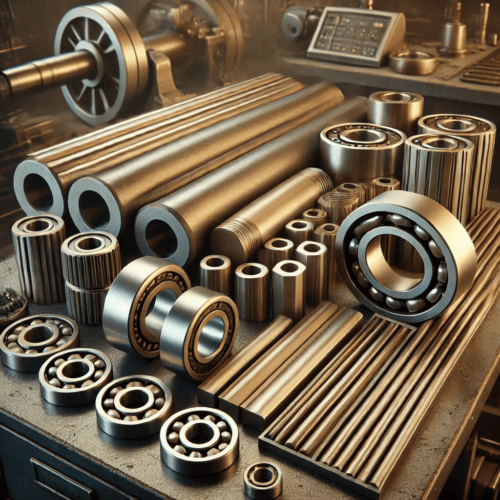
Continued Market Volatility
- Ongoing geopolitical conflicts and trade tensions could continue to disrupt metal supplies, leading to unpredictable price changes.
- The electric vehicle boom and increasing investments in renewable energy infrastructure will maintain high demand for copper and aluminum, potentially driving prices up in the short term.
Strategies for Navigating Metal Price Fluctuations
Companies in the bearing and bushing industries must adopt strategies to mitigate the risks associated with volatile metal prices.
- Diversifying Supply Chains: Establishing partnerships with multiple suppliers ensures a steady supply of critical materials.
- Adopting Sustainable Practices: Using eco-friendly alloys and promoting recycling efforts can reduce exposure to price swings.
- Investing in R&D: Innovations in manufacturing processes, such as Lube-Align bearings, offer operational efficiencies and long-term cost savings.

The Role of Companies Like Bunting Bearings
Companies such as Bunting Bearings play a pivotal role in providing solutions that address both performance and sustainability challenges. Their extensive range of products, including powdered metal bars and self-lubricating bushings, demonstrates the importance of material innovation in a competitive market.
Similarly, our friends over at Bushings and Bars specialize in customized metal components, ensuring that clients receive the most appropriate solutions for their specific needs. Both companies highlight the importance of proactive strategies to manage metal price fluctuations, ensuring continuity and quality for their customers.
The bearing and bushing industries operate within a dynamic environment where metal prices play a crucial role. From the historical evolution of bronze and powdered metals to the current challenges posed by market volatility and supply chain disruptions, understanding these trends is essential for industry players. Companies like Bunting Bearings are well-positioned to navigate these challenges by leveraging innovation, sustainability, and strategic partnerships.
Looking ahead, the focus on green materials and advanced manufacturing technologies will continue to shape the future of the industry. By staying ahead of these trends, businesses can ensure long-term success while meeting the evolving needs of their customers.
For more detailed information on specific products and innovations, visit Bunting Bearings.
As a broader category, bronze bushings are desirable for their longevity and resistance properties, but there are still significant differences between cast bronze bushings and oil-impregnated bronze bushings. While similar in many ways, these component types are manufactured using completely different processes, and these processes lend themselves to different physical characteristics.
At Bunting Bearings, our oil-impregnated bronze bushings are made by the powder metal process while the cast variety are produced through more traditional machining methods. It’s important to understand how this distinction affects the final product, as one type may be more appropriate for your application than the other.
Oil-Impregnated Bronze Bushings
Oil-impregnated bronze bushings are characterized by their ability to self-lubricate. This effect is possible because of the powder metallurgy process:
- Bronze powder is gravity fed into a die set which is the desired bushing size. The powder is then pressed to connect the powder particles together.
- The powder particles in the part are then bonded together in a furnace. The furnace temperature is just high enough to bond the particles without melting the metal.
- This sintering procedure is the key to oil impregnation. Sintering, by nature, decreases the porosity of the product as it bonds the powder particles together, but it’s possible to control the degree to which this happens.
- For oil-impregnated bronze bushings, the final porosity is maintained at around 25%, meaning that there are still tiny, interconnected capillaries woven throughout the material.
- To finish the manufacturing process the bushing is then pressed through a calibration set of tools to the required tolerances. The bushing is then vacuum impregnated which forces oil into the interconnected porosity.
Benefits and Applications
Powder metallurgy was originally developed as a cost-effective alternative to standard machining and remains an extremely economical option. In most cases, it is one of the most efficient methods of high-volume production, which translates into cost savings on the consumer end. Oil impregnation also eliminates the need for lubricants and frequent maintenance.
Oil-impregnated bushings originated as an automotive component, however they are used in many other industries. Generally, our oil-impregnated bronze bushings are best-suited for low-to-moderate loads, but they do tolerate high-velocity loads better than many alternatives. They also function well across a wide temperature range of approximately 10–220°F, meaning that they are suitable for use in outdoor and industrial environments.
Cast Bronze Bushings
Unlike oil-impregnated bushings, cast bronze bushings are not formed from powder. Instead, they are formed from a solid or hollow bronze cast bar that undergoes machining processes designed to achieve a precise final shape.
- First bronze is continuous or centrifugally cast into a solid or hollow bar.
- Most modern manufacturers use a CNC lathe to cut the cast bar to its final size, although other machining techniques may be used for forming or finishing the bushing.
Benefits & Applications
Cast bronze bushings do not begin as a powder, so they are able to maintain a finer grain structure and therefore a higher degree of strength. In general, cast bronze bushings are also stronger, more durable, and more reliable under compressive force. This combination of properties makes cast bushings an ideal choice for applications involving heavier loads. A sintered bronze bushing of comparable size would simply be unable to withstand the same forces as a cast one.
Bunting Bearings’ Selection of Bronze Bushings
Regardless of your decision between cast and oil-impregnated bronze bushings, Bunting Bearings is ready to fulfill your order with durable, high-quality components. Our extensive catalog includes both plain and flanged bushing designs made from cast bronze. Oil-impregnated options are also available in a comparable range of designs, all of which conform to ASTM standards for chemical properties, physical properties, and tolerances.
At Bunting Bearings, we’ve earned our reputation as a trustworthy provider for stock and custom components. As one of the largest providers of bronze bearings in the nation, we are dedicated to offering exactly the parts you need at the right prices.
For details specific to your project, request a quote or contact our experienced team today.
Bearings and bushings come in a range of sizes and can be made out of metal, plastic composites, or a combination of the two. This variety means you can find exactly what you need for a specific project; however, with so many choices, how do you decide the best option for you? Plastic and metal both have unique characteristics and advantages, and your choice will depend on the project, your budget, and more.
Plastic Bushings
Affordable and versatile, plastic bushings are used for many different industries, such as agricultural, medical, and machines, including fitness equipment, lawn mowers, food processing machinery, pumps, and valves. Because production of these bushings is fast and cost-effective, choosing plastic over metal could save you money depending on the type of plastic you choose.
Engineered plastic bushings have a predictable wear rate, meaning you can accurately calculate the service life for an application based on a tribological test database. You can accurately determine their service life span and replace them before they malfunction, knowing you used them exactly as long as you could. That means less guesswork, fewer errors, and more time and money saved.
Plastic bushings are corrosion and chemical resistant as well as self-lubricating—no grease required! If you think plastic is unable to stand up to heat, you might be surprised to learn these bushings can withstand temperatures up to 900°F for short periods. Over longer periods, they can perform in temperatures up to 482°F.
Bronze Bushings
With all the benefits of plastic, where does that leave metal? Bronze remains a popular choice for bushings because it’s available in so many alloys and compositions, expanding its reach into even more applications. A bronze bushing is harder and less likely to break or deform than those made of other materials.
Like plastic, bronze bushings are long-lasting and corrosion resistant. As noted above, their strength allows them to hold up under impact. One potential disadvantage is that metal requires a lubricant to reduce friction and prolong the bearing’s service life. Oil or grease must be applied at installation and during operation.
Still, the benefits may outweigh that small inconvenience. Bronze bushings are common in low-speed, high-load as well as high speed, low load industrial applications, including:
- Iron and steel manufacturing
- Food processing
- Valves
- Automobiles
Let’s take a closer look at two common bronze bushing materials:
- SAE841 Sintered Bronze:These oil-impregnated bronze bushings can be used with both high and low speeds, as well as high and low temperatures, depending upon the type of oil. SAE841 is also used for applications requiring food-grade quality.
- Cast Bronze:The extra corrosion resistance with these alloys (typically bronze with tin, aluminum, or silicon) makes it especially useful in wet environments.
Bunting Bushing Solutions
Whether you need bronze or plastic bushings, Bunting Bearings can fill your needs. We have engineered parts available in nylon, PTFE, various bronze alloys and more:
- Vespel®: This brings the best of plastic, metal, and ceramic together for a bearing that can manage high speeds, heavy loads, and high temperatures.
- Nylatron: Cost-effective and self-lubricating, this is a nylon modified with molybdenum disulfide lubricant powder.
- PTFE: Four different PTFE material bushings are held in stock including a non-toxic FDA compliant range.
- BU: This unique composite features a steel backing and a bronze layer impregnated with PTFE for a strong mechanical bond.
- Cast Bronze: A full range of leaded tin bronze bearings are in stock plus a full range of sleeve and flanged bushing made from ECO BRONZE which in independent tests proved to be superior to other cast lead-free materials.
If you’re not sure which bearings are right for you, contact us. We’ll answer your questions about the advantages of each option and help you figure out which one will work best for your application.
Flanges feature a projecting rim over the edge of another part, a collar to secure connecting pieces together, or a ring to provide pressure to holds components in place. They enable part fabricators to customize the function of end products for customers.
Ultimately, flanges provide strength and stiffness at more vulnerable areas of a part and facilitate the connection of diverse components. They are also useful in mounting and positioning static items. When paired with bearings on the external housing of a device, flanges increase the ability of the end product to effectively handle radial and thrust loads.
Flanges are one of the most popular types of bearings requested by our clients at Bunting Bearings. This introduction to bronze flanged bearings will help readers understand what they are and what they can do for industrial manufacturing and assembly projects.
The Benefits of Bronze
Bronze alloys predominantly consist of copper and tin. Additional metals are added to the mix – i.e. aluminum, manganese, nickel, or zinc – to achieve the desired metallurgy. This results in a bronze material with ideal physical properties to suit the needs of the end application. For example, bronze can be tailored to have a specific physical appearance and offer better protection for end components against corrosion and surrounding conditions like moisture.
Bronze bearings and bushings are made to be rigid and tough. In comparison to those made of brass, bronze parts last longer and hold their shape better under repeated use. Bronze greatly improves resistance to:
- Impact
- Shock
- Corrosion
- Mechanical wear-and-tear
This means that bronze bearings last longer than their softer and more malleable brass counterparts. Bronze also causes less friction when brought in contact with other metal parts, which helps to extend the life of the bearing.
Applications and Advantages of Bronze Flanged Bearings
The versatility of bronze flanged bearings makes them an ideal fit for a number of industrial applications. Bronze flanged bearings are known for their low-maintenance durability. Heavy-duty industrial operations that rely on low-speed, high-load processes are particularly good candidates for bronze flange bearings, which hold up well under immense and repeated pressure.
Bronze flanged bearings are often found in equipment used in:
- Iron and steel manufacturing
- Food processing
- Injection molding
- Automotive equipment
- Earth movers
- Industrial pumps
The additional metal alloys that make up the bronze impart beneficial characteristics to the resulting material. Some of the common alloys used for bronze flanges include:
- Oil is infused into the alloy via powder metallurgy. Depending on its composition, SAE841 can accommodate for a wide range of speeds and temperature ranges. It is often used in food-grade applications.
- Aluminum, tin, and silicone. Marine manufacturers value the high corrosion-resistance of copper, but must alloy the copper with other materials to improve its strength. Copper alloyed with aluminum, tin, or silicone creates a bronze that enables manufacturers to create water-tight vessels without excessive weight.
Speak to your bearing provider for personalized bronze flanged bearing guidance based on your specifications.
Bronze Flange Bearings at Bunting Bearings
Bunting Bearings stocks a comprehensive line of cast bronze bearings, flange bearings, and much more. All of our parts are produced with P/M bronze for superior performance and durability. We are proud to serve our clients with high-quality stock parts.
Our Bronze Flanged Bearings SAE 841 conform to ASTM chemical and physical standards. They are the first of their kind to include all ASTM standard sizes, recommended dimensions, and tolerances. Operations and processes with large variations in temperature benefit from our oil-based bronze bearings. With the ability to function in temperatures that range from 10° F to 220°F, these parts are a convenient and cost-effective way to meet your application and equipment needs.
For more information on bronze flanged bearing products and services from Bunting Bearings, please contact us today.
With our recent purchase of six new Samsung CNC turning lathes with live tooling, Bunting Bearings is better equipped than ever to meet our customers’ needs. Two of these new additions were installed into a manual cell, while three were installed into a fully robotized cell, so they can be applied towards both low- and high-volume projects.
The sixth and largest machine of the group is the Samsung SL65/3200. It was installed to be used in conjunction with a VTL machine. We are excited about our new machining capabilities and what it means for our customers. Here is an overview of what CNC turning lathes do and the opportunities that our new equipment has created for our customers.
What Is a Live Tooling CNC Lathe?
A Computer Numerical Controlled (CNC) turning lathe is an automated tool that produces high-quality parts on a reliable, consistent basis. In a CNC lathe, the part itself spins while single-point cutters move across the part to create the desired shape, smoothness, and design; appropriate positioning of the part is provided by the main spindle’s ability to index precisely.
A programmer can design the part manually, or the part can be designed via computer-aided design (CAD) programs. From there, the computer directs the tool to make the appropriate cuts. After the design is perfected—which may require testing and adjustments to solidify the design—and production has begun, there is little need for constant supervision. The CNC lathe is highly precise and will continue making identical parts until all are complete. It can then be reprogrammed for a new part’s production. CAD parts can be saved and easily reapplied if a customer places another order for the same part in the future.
Our new live tooling CNC turning lathes give us a variety of options and functions with one simple set-up. When the part is stopped from spinning, driven tools (axial or radial) are able to create grooves and holes around the entire part as required. Without live tooling, we would have to remove the piece and go through additional steps to create grooves or holes, which adds on time, labor, and risks of error. Those live tooling capabilities within the CNC lathe are a major boost to productivity and accuracy.
What This Means for Our Customers
These new live tooling lathes are a worthwhile investment for Bunting Bearings, and a logical step in our growth process. We are now able to offer competitive pricing while producing parts with even greater precision. With fewer set-ups and less manual supervision, we can accomplish more in less time; our increased productivity means faster turnaround times and cost savings for you. With the two machines in the manual cell, we can maintain those quick turnarounds even on low volume runs.
As for the SL65, here are some of its specs, for insights to what it is capable of:
- 24” chuck
- 6” maximum swing
- 126” maximum turning length
- 5” diameter bar feed capacity
- 12-station heavy duty turret
It also allows us to produce parts with live tooling ranging from diameters of 3/8” to 10.” We are glad to speak with you about any special needs or custom orders you have in mind.
Since our humble beginnings as Bunting Brass & Bronze in 1907, Bunting Bearings has grown to become one of the largest producers of bronze bearings in the country. From the start, our innovations have been driven by our desire to produce the best bearings possible to serve our customers. We are always looking for new ways to increase the value we offer you, our productivity, and to further improve the quality of our products, and our six new CNC turning lathes are part of this commitment.
We proudly produce a diverse range of bearings, including custom products, to suit your needs. To learn more about our new CNC turning lathes or our capabilities and services, contact us today.
Bunting Bearings is the premiere name in the niche of environmentally-friendly bearing and cast bar solutions and supplies leading producers of sustainable energy, marine, medical and other commercial products with high quality bronze bushings and cast bars. Our eco-friendly alloy C87850 ECO Bronze is RoHS compliant and meets the lead-free safe drinking water act. The main difference between our ECO BRONZE and other lead-free alternatives is that ECO BRONZE is a great bearing material.
Other materials compromise their bearing properties to become lead-free, but ECO BRONZE has proved to be as good as, and in some cases superior to, the leaded material it has replaced.
ECO BRONZE is probably the most tested lead-free bronze material to-date; Bunting Bearings and Chase Brass had this material arduously tested by various independent laboratories in the USA, and all came to the same conclusion: “it’s tough,” “non-galling,” “does not get brittle at high temperatures,” “superior impact and compressive strength,” and “a great bearing material. Eco Bronze has gained acceptability in the potable water pump industry as it is S3874 & AB1953 compliant, it’s also gained acceptance in other industries such as construction equipment, Wind tower, food processing, medical devices and many others due to its great bearing properties.
By incorporating ECO BRONZE into your manufacturing supply chain, your business can easily reach its sustainability goals. Being environmentally responsible is a goal that Bunting, Chase Brass and most of our customers share. By specifying a green product such as ECO BRONZE in lieu of a traditional leaded material you have taken a significant step forward. Furthermore, by leading your company with the procurement change your employees can take note and find additional ways for your business to decrease its environmental footprint. Selecting eco-friendly bronze products is just the start – how else does your facility plan to increase sustainability this year?
First, What is Tribology?
Tribology is the study of friction and wear on surfaces and materials that are in motion. Bearings are the perfect example of products that would require some background in tribology, since they are constantly rubbing against other items in their everyday function.
Bunting Bearings has always been at the forefront of bearing calculations including PV wear and friction data, and when we required independent verification on how effective a bearing material our new lead free ECO Bronze material was, we turned to the leading US tribology expert, Dr. Robert Adams.
Dr. Adams’ doctoral research was focused on characterizing plane bearing materials’ PV friction and wear performance profiles. Dr. Adams applied his knowledge to develop a tribometer that reduced the time needed to obtain reliable PV wear and friction test results. Dr. Adams’s company, Tribis Engineering Inc., is now finalizing all the PV data that will show that ECO Bronze is the first real cost competitive material to current leaded and lead free bronze bearing materials.
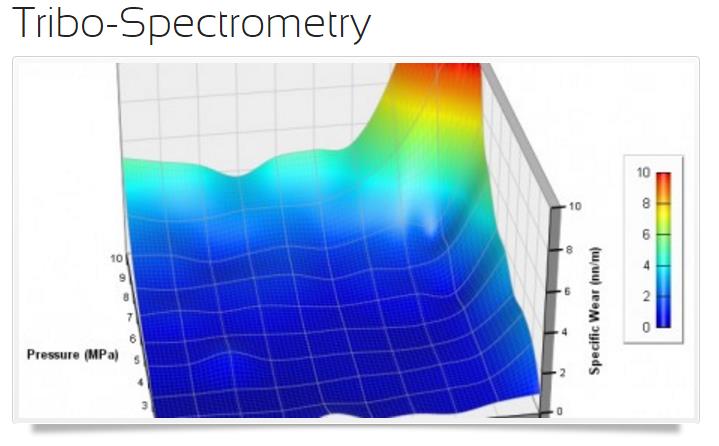
Bunting will be releasing tribological data on many of our bronze compounds in the near future.
There is not a single “best” bearing material and surface combination. Understanding how the various materials compare under these changing conditions makes it possible to select the “best” bearing material and surface combination for a particular application.
Tribo-spectrometry helps us to understand the particular friction and wear behavior of differing materials, and make the right choices for current needs.
British Petroleum and Royal Dutch Shell have declared that by 2050, most of the world’s energy needs will be met using alternative or clean energy. Renewable sources like natural gas, wind power and geothermal hot spots are valued for their clean properties.
Wind energy is fast growing in popularity and thanks to recent developments has experienced a surge in production volume, accompanied by a dip in the cost of set-up and expansion. And geothermal energy harvested from the heat of the Earth’s core is ever abundant and produces steam which in turn can drive turbine based devices to generate electricity.
Sustainable energy providers work to supply cities and operational activities like manufacturing with adequate clean power. To further accelerate the process of going green, vendors can use responsibly sourced or ‘sustainable’ materials to update infrastructure. This may include lead free bearings or items like reclaimed wood to replace traditional provisioning.
Bunting Bearings is a premiere name in the niche of environmentally friendly bearing solutions and supplies sustainable energy providers, marine, medical and other commercial markets with high quality components. Our eco-friendly alloys like the C87850 ECO Bronze, C95400 Aluminium- Bronze, C89835 Bismuth bronze are RoHS compliant and meet the lead-free safe drinking water act and are manufactured for use in heavy machinery and on rugged terrains.
By incorporating these materials into your manufacturing supply chain, your business can more easily reach sustainability goals. And by greening processes at the procurement level, employees can take note and find additional ways for the company to decrease its environmental footprint. Selecting eco-friendly industrial products is just the start – how else does your facility plan to increase sustainability this year? Let us know on Twitter.
When most people think of a powder metal bearing they think of Bronze normally made to the SAE841, MPIF CT-1000-K26 or similar specification, but they don’t think of powder metal for heavy loaded bearing applications. Many years ago Bunting pioneered BB16 as a heat treated iron copper material to handle these applications. It was branded as “The world’s best kept secret” but this is no longer true for some heavy industry users.
Typical uses of Bunting’s BB16 material are for off road equipment, earth moving equipment, escalators and the US Military. BB16 is heat treated to a Rockwell Hardness B scale (HRB) of 70 to increase its resistance to deformity under heavy loads. Similar to our standard Bronze bearing line, BB16 bearings are vacuum impregnated with Oil. However BB16 bearings contain extreme pressure oil which remains in the pores of the bearing to provide lubrication from the bearing to the shaft during operation. However, BB16 possesses a maximum load value of 8,000 psi (pounds per square inch), a maximum velocity value of 35 sfpm (surface feet per minute), and a maximum load-at-velocity (PV) value of 75,000. BB16 bearings can operate at temperatures ranging from -10 degrees F to 220 F (-12 degrees C to 104 C). If your application requires a self-lubricating bearing that can withstand high loads, then Buntings BB16 may be able to solve your problem.













